Human Rights Breaches: A Case Study of Women Violation in Australia
VerifiedAdded on 2023/06/12
|5
|1298
|230
Case Study
AI Summary
This case study explores the issue of women violation in Australia, focusing on domestic violence and its implications for human rights. It highlights specific instances, such as the murders of Allison Baden-Clay and Luke Batty, which have brought the issue to the forefront. The study examines the evolving definition of domestic violence in Australia, including physical, sexual, verbal, social, spiritual, psychological, and economic abuse. It references statistics on domestic assaults and intervention orders, emphasizing the prevalence of violence against women. The case study then analyzes breaches of the Convention on the Elimination of All Forms of Discrimination Against Women (CEDAW), specifically Article 1 (discrimination), Article 3 (guarantee of basic human rights), and Article 5 (sex role stereotyping). It concludes that Australian society still faces challenges in ensuring women's rights and eliminating discrimination, as evidenced by the ongoing prevalence of domestic violence and the perpetuation of harmful stereotypes. Desklib provides similar case studies and resources for students.
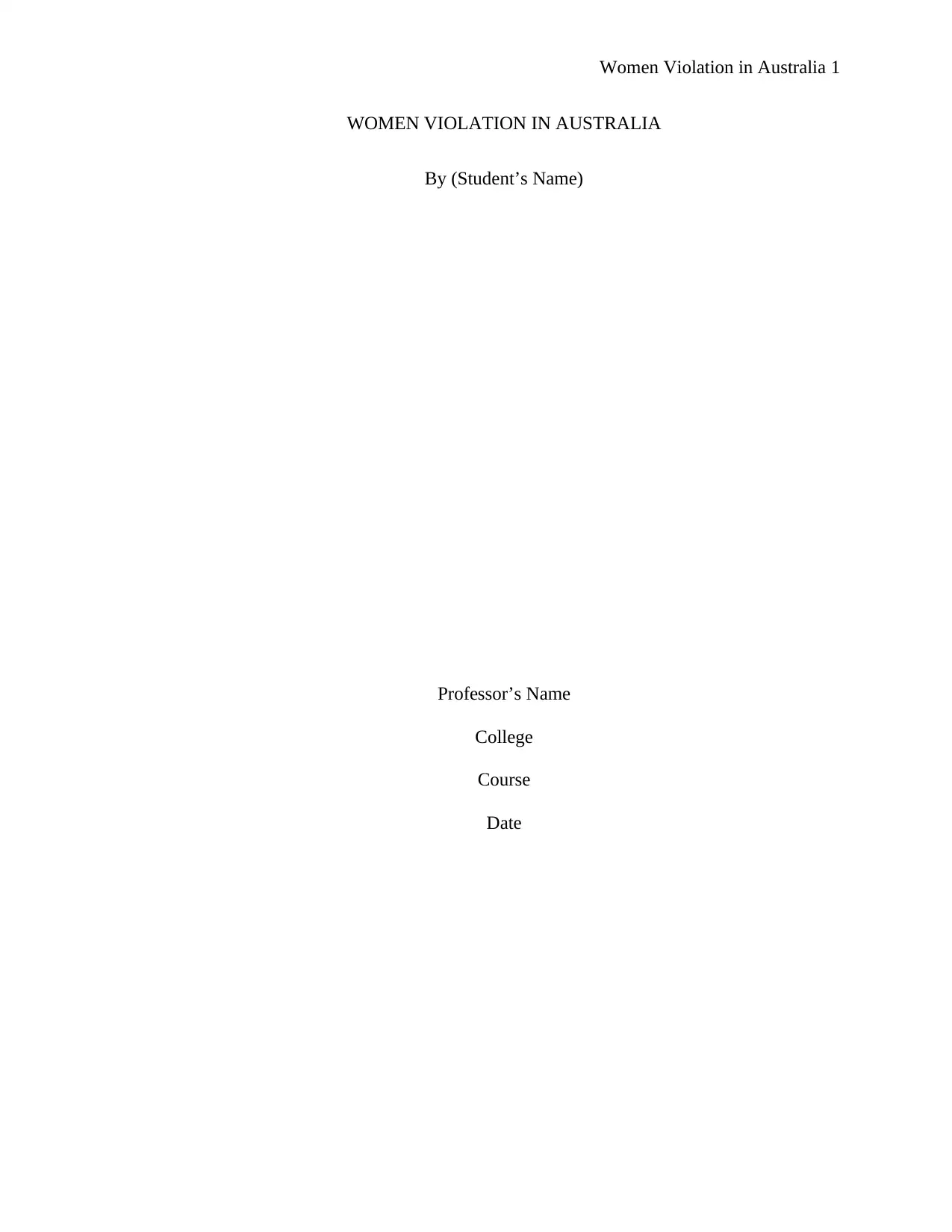
Women Violation in Australia 1
WOMEN VIOLATION IN AUSTRALIA
By (Student’s Name)
Professor’s Name
College
Course
Date
WOMEN VIOLATION IN AUSTRALIA
By (Student’s Name)
Professor’s Name
College
Course
Date
Paraphrase This Document
Need a fresh take? Get an instant paraphrase of this document with our AI Paraphraser
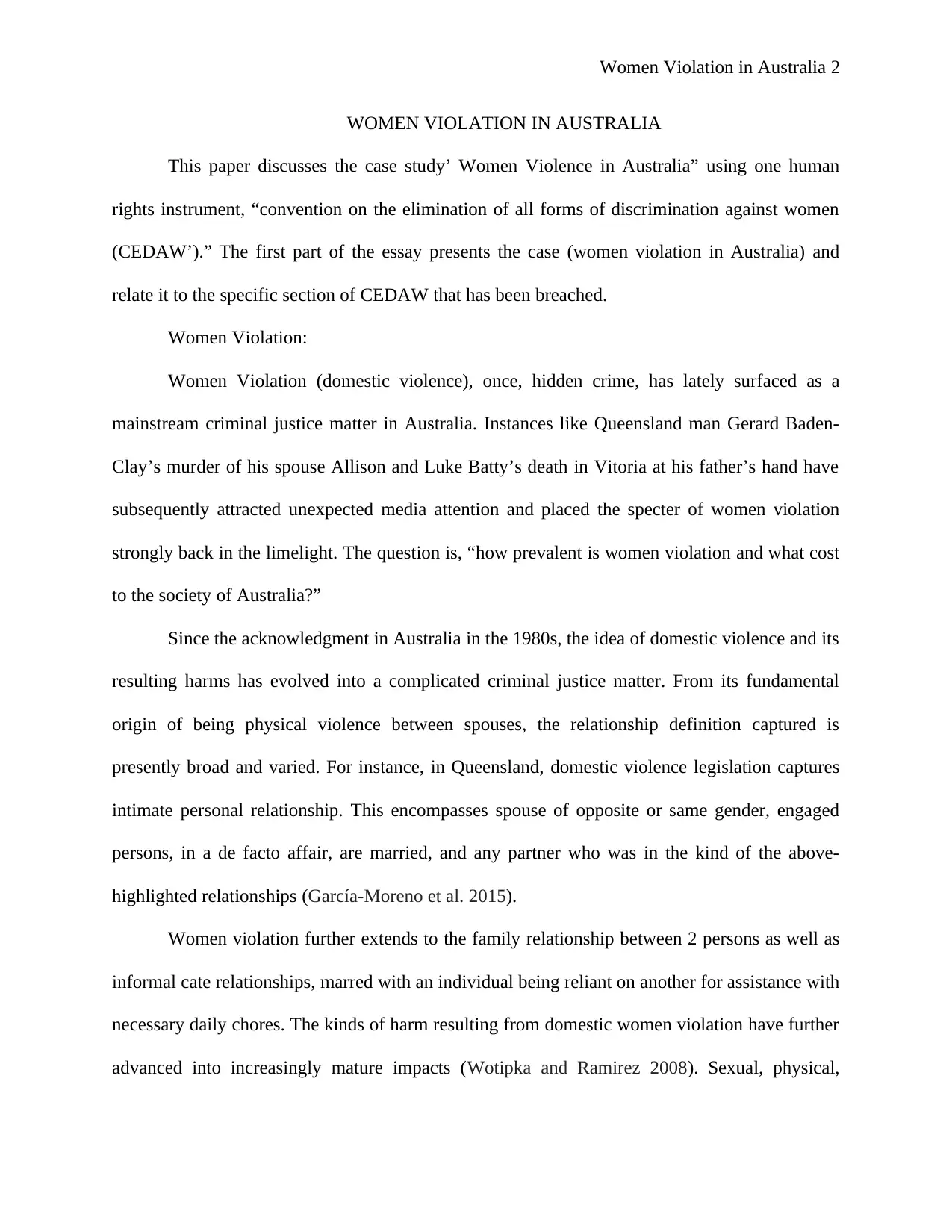
Women Violation in Australia 2
WOMEN VIOLATION IN AUSTRALIA
This paper discusses the case study’ Women Violence in Australia” using one human
rights instrument, “convention on the elimination of all forms of discrimination against women
(CEDAW’).” The first part of the essay presents the case (women violation in Australia) and
relate it to the specific section of CEDAW that has been breached.
Women Violation:
Women Violation (domestic violence), once, hidden crime, has lately surfaced as a
mainstream criminal justice matter in Australia. Instances like Queensland man Gerard Baden-
Clay’s murder of his spouse Allison and Luke Batty’s death in Vitoria at his father’s hand have
subsequently attracted unexpected media attention and placed the specter of women violation
strongly back in the limelight. The question is, “how prevalent is women violation and what cost
to the society of Australia?”
Since the acknowledgment in Australia in the 1980s, the idea of domestic violence and its
resulting harms has evolved into a complicated criminal justice matter. From its fundamental
origin of being physical violence between spouses, the relationship definition captured is
presently broad and varied. For instance, in Queensland, domestic violence legislation captures
intimate personal relationship. This encompasses spouse of opposite or same gender, engaged
persons, in a de facto affair, are married, and any partner who was in the kind of the above-
highlighted relationships (García-Moreno et al. 2015).
Women violation further extends to the family relationship between 2 persons as well as
informal cate relationships, marred with an individual being reliant on another for assistance with
necessary daily chores. The kinds of harm resulting from domestic women violation have further
advanced into increasingly mature impacts (Wotipka and Ramirez 2008). Sexual, physical,
WOMEN VIOLATION IN AUSTRALIA
This paper discusses the case study’ Women Violence in Australia” using one human
rights instrument, “convention on the elimination of all forms of discrimination against women
(CEDAW’).” The first part of the essay presents the case (women violation in Australia) and
relate it to the specific section of CEDAW that has been breached.
Women Violation:
Women Violation (domestic violence), once, hidden crime, has lately surfaced as a
mainstream criminal justice matter in Australia. Instances like Queensland man Gerard Baden-
Clay’s murder of his spouse Allison and Luke Batty’s death in Vitoria at his father’s hand have
subsequently attracted unexpected media attention and placed the specter of women violation
strongly back in the limelight. The question is, “how prevalent is women violation and what cost
to the society of Australia?”
Since the acknowledgment in Australia in the 1980s, the idea of domestic violence and its
resulting harms has evolved into a complicated criminal justice matter. From its fundamental
origin of being physical violence between spouses, the relationship definition captured is
presently broad and varied. For instance, in Queensland, domestic violence legislation captures
intimate personal relationship. This encompasses spouse of opposite or same gender, engaged
persons, in a de facto affair, are married, and any partner who was in the kind of the above-
highlighted relationships (García-Moreno et al. 2015).
Women violation further extends to the family relationship between 2 persons as well as
informal cate relationships, marred with an individual being reliant on another for assistance with
necessary daily chores. The kinds of harm resulting from domestic women violation have further
advanced into increasingly mature impacts (Wotipka and Ramirez 2008). Sexual, physical,
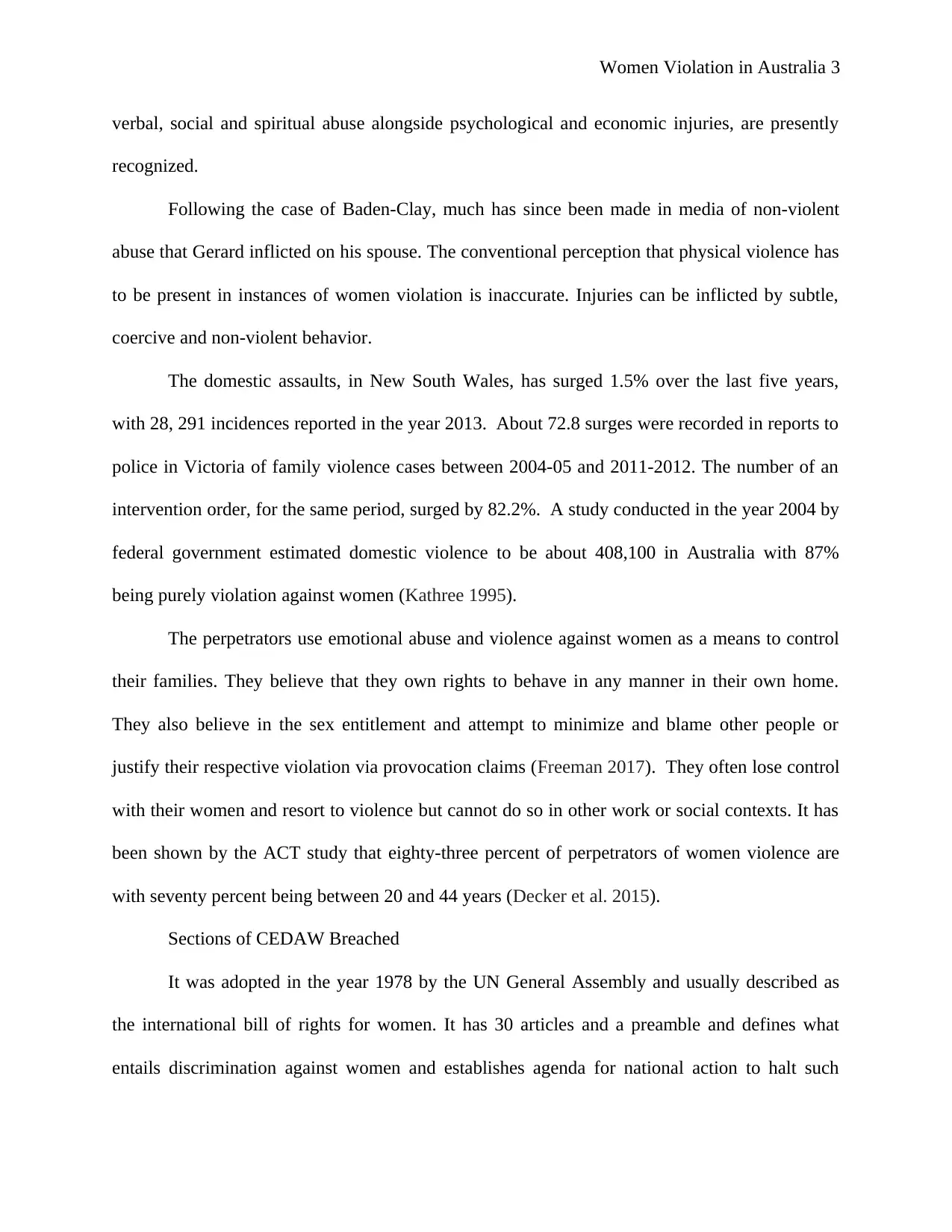
Women Violation in Australia 3
verbal, social and spiritual abuse alongside psychological and economic injuries, are presently
recognized.
Following the case of Baden-Clay, much has since been made in media of non-violent
abuse that Gerard inflicted on his spouse. The conventional perception that physical violence has
to be present in instances of women violation is inaccurate. Injuries can be inflicted by subtle,
coercive and non-violent behavior.
The domestic assaults, in New South Wales, has surged 1.5% over the last five years,
with 28, 291 incidences reported in the year 2013. About 72.8 surges were recorded in reports to
police in Victoria of family violence cases between 2004-05 and 2011-2012. The number of an
intervention order, for the same period, surged by 82.2%. A study conducted in the year 2004 by
federal government estimated domestic violence to be about 408,100 in Australia with 87%
being purely violation against women (Kathree 1995).
The perpetrators use emotional abuse and violence against women as a means to control
their families. They believe that they own rights to behave in any manner in their own home.
They also believe in the sex entitlement and attempt to minimize and blame other people or
justify their respective violation via provocation claims (Freeman 2017). They often lose control
with their women and resort to violence but cannot do so in other work or social contexts. It has
been shown by the ACT study that eighty-three percent of perpetrators of women violence are
with seventy percent being between 20 and 44 years (Decker et al. 2015).
Sections of CEDAW Breached
It was adopted in the year 1978 by the UN General Assembly and usually described as
the international bill of rights for women. It has 30 articles and a preamble and defines what
entails discrimination against women and establishes agenda for national action to halt such
verbal, social and spiritual abuse alongside psychological and economic injuries, are presently
recognized.
Following the case of Baden-Clay, much has since been made in media of non-violent
abuse that Gerard inflicted on his spouse. The conventional perception that physical violence has
to be present in instances of women violation is inaccurate. Injuries can be inflicted by subtle,
coercive and non-violent behavior.
The domestic assaults, in New South Wales, has surged 1.5% over the last five years,
with 28, 291 incidences reported in the year 2013. About 72.8 surges were recorded in reports to
police in Victoria of family violence cases between 2004-05 and 2011-2012. The number of an
intervention order, for the same period, surged by 82.2%. A study conducted in the year 2004 by
federal government estimated domestic violence to be about 408,100 in Australia with 87%
being purely violation against women (Kathree 1995).
The perpetrators use emotional abuse and violence against women as a means to control
their families. They believe that they own rights to behave in any manner in their own home.
They also believe in the sex entitlement and attempt to minimize and blame other people or
justify their respective violation via provocation claims (Freeman 2017). They often lose control
with their women and resort to violence but cannot do so in other work or social contexts. It has
been shown by the ACT study that eighty-three percent of perpetrators of women violence are
with seventy percent being between 20 and 44 years (Decker et al. 2015).
Sections of CEDAW Breached
It was adopted in the year 1978 by the UN General Assembly and usually described as
the international bill of rights for women. It has 30 articles and a preamble and defines what
entails discrimination against women and establishes agenda for national action to halt such
⊘ This is a preview!⊘
Do you want full access?
Subscribe today to unlock all pages.

Trusted by 1+ million students worldwide
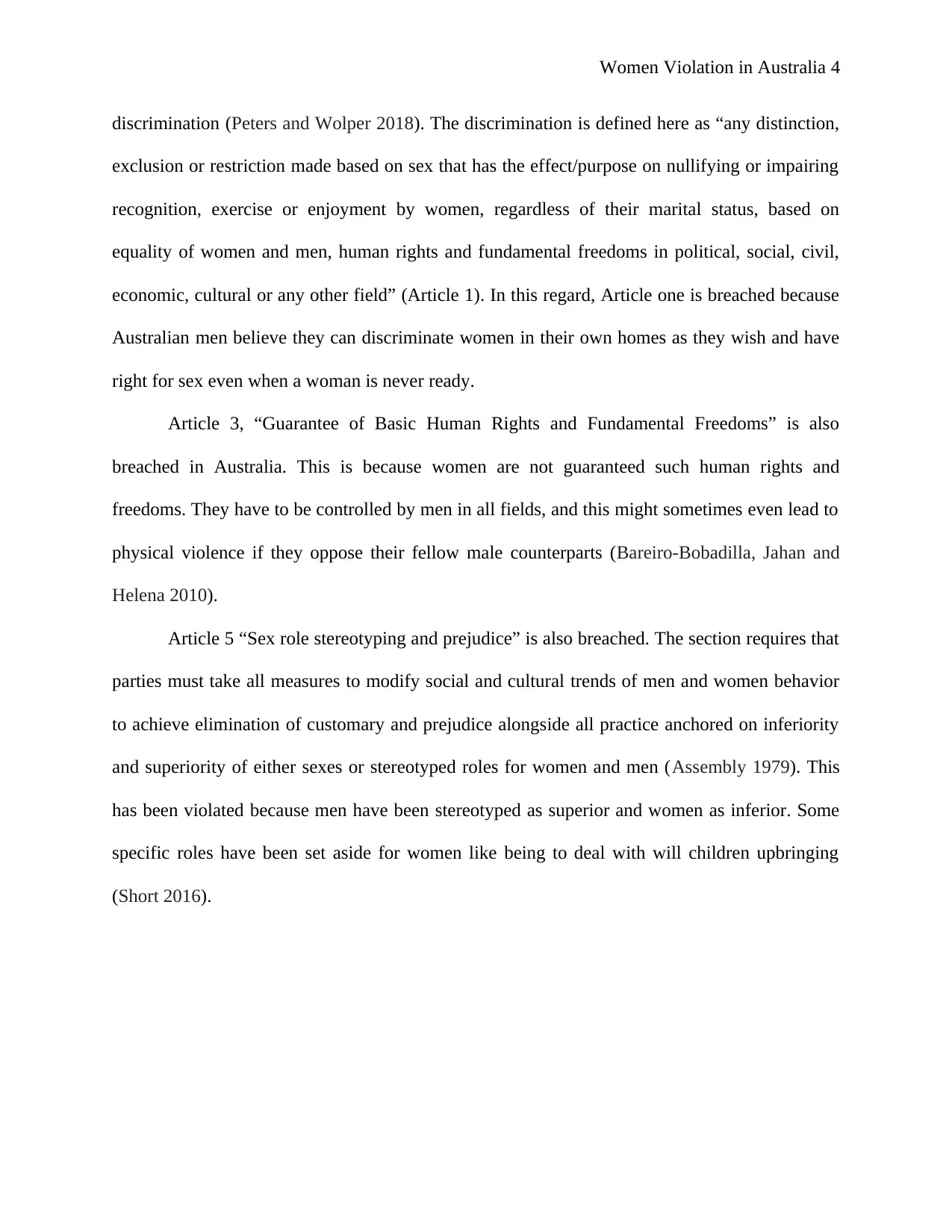
Women Violation in Australia 4
discrimination (Peters and Wolper 2018). The discrimination is defined here as “any distinction,
exclusion or restriction made based on sex that has the effect/purpose on nullifying or impairing
recognition, exercise or enjoyment by women, regardless of their marital status, based on
equality of women and men, human rights and fundamental freedoms in political, social, civil,
economic, cultural or any other field” (Article 1). In this regard, Article one is breached because
Australian men believe they can discriminate women in their own homes as they wish and have
right for sex even when a woman is never ready.
Article 3, “Guarantee of Basic Human Rights and Fundamental Freedoms” is also
breached in Australia. This is because women are not guaranteed such human rights and
freedoms. They have to be controlled by men in all fields, and this might sometimes even lead to
physical violence if they oppose their fellow male counterparts (Bareiro-Bobadilla, Jahan and
Helena 2010).
Article 5 “Sex role stereotyping and prejudice” is also breached. The section requires that
parties must take all measures to modify social and cultural trends of men and women behavior
to achieve elimination of customary and prejudice alongside all practice anchored on inferiority
and superiority of either sexes or stereotyped roles for women and men (Assembly 1979). This
has been violated because men have been stereotyped as superior and women as inferior. Some
specific roles have been set aside for women like being to deal with will children upbringing
(Short 2016).
discrimination (Peters and Wolper 2018). The discrimination is defined here as “any distinction,
exclusion or restriction made based on sex that has the effect/purpose on nullifying or impairing
recognition, exercise or enjoyment by women, regardless of their marital status, based on
equality of women and men, human rights and fundamental freedoms in political, social, civil,
economic, cultural or any other field” (Article 1). In this regard, Article one is breached because
Australian men believe they can discriminate women in their own homes as they wish and have
right for sex even when a woman is never ready.
Article 3, “Guarantee of Basic Human Rights and Fundamental Freedoms” is also
breached in Australia. This is because women are not guaranteed such human rights and
freedoms. They have to be controlled by men in all fields, and this might sometimes even lead to
physical violence if they oppose their fellow male counterparts (Bareiro-Bobadilla, Jahan and
Helena 2010).
Article 5 “Sex role stereotyping and prejudice” is also breached. The section requires that
parties must take all measures to modify social and cultural trends of men and women behavior
to achieve elimination of customary and prejudice alongside all practice anchored on inferiority
and superiority of either sexes or stereotyped roles for women and men (Assembly 1979). This
has been violated because men have been stereotyped as superior and women as inferior. Some
specific roles have been set aside for women like being to deal with will children upbringing
(Short 2016).
Paraphrase This Document
Need a fresh take? Get an instant paraphrase of this document with our AI Paraphraser
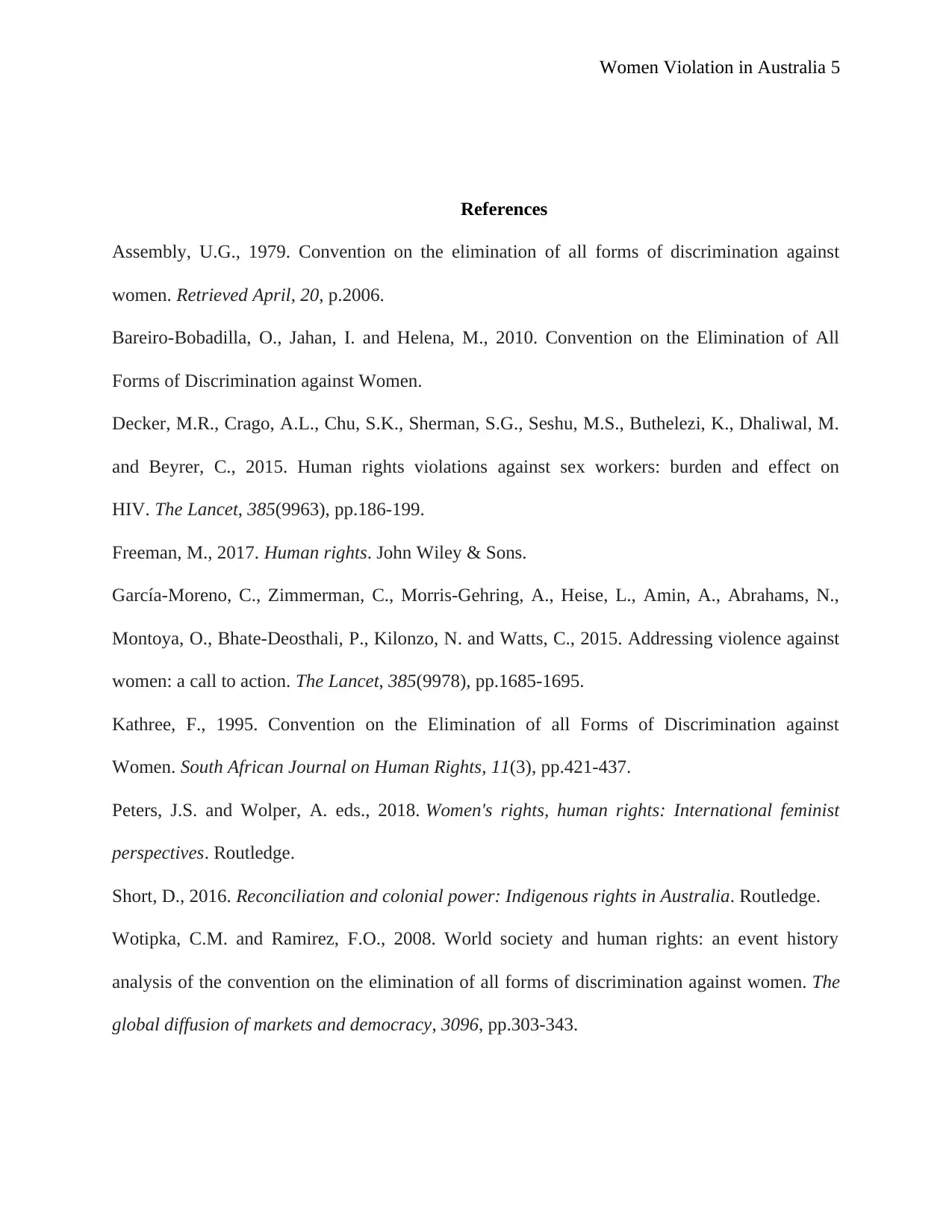
Women Violation in Australia 5
References
Assembly, U.G., 1979. Convention on the elimination of all forms of discrimination against
women. Retrieved April, 20, p.2006.
Bareiro-Bobadilla, O., Jahan, I. and Helena, M., 2010. Convention on the Elimination of All
Forms of Discrimination against Women.
Decker, M.R., Crago, A.L., Chu, S.K., Sherman, S.G., Seshu, M.S., Buthelezi, K., Dhaliwal, M.
and Beyrer, C., 2015. Human rights violations against sex workers: burden and effect on
HIV. The Lancet, 385(9963), pp.186-199.
Freeman, M., 2017. Human rights. John Wiley & Sons.
García-Moreno, C., Zimmerman, C., Morris-Gehring, A., Heise, L., Amin, A., Abrahams, N.,
Montoya, O., Bhate-Deosthali, P., Kilonzo, N. and Watts, C., 2015. Addressing violence against
women: a call to action. The Lancet, 385(9978), pp.1685-1695.
Kathree, F., 1995. Convention on the Elimination of all Forms of Discrimination against
Women. South African Journal on Human Rights, 11(3), pp.421-437.
Peters, J.S. and Wolper, A. eds., 2018. Women's rights, human rights: International feminist
perspectives. Routledge.
Short, D., 2016. Reconciliation and colonial power: Indigenous rights in Australia. Routledge.
Wotipka, C.M. and Ramirez, F.O., 2008. World society and human rights: an event history
analysis of the convention on the elimination of all forms of discrimination against women. The
global diffusion of markets and democracy, 3096, pp.303-343.
References
Assembly, U.G., 1979. Convention on the elimination of all forms of discrimination against
women. Retrieved April, 20, p.2006.
Bareiro-Bobadilla, O., Jahan, I. and Helena, M., 2010. Convention on the Elimination of All
Forms of Discrimination against Women.
Decker, M.R., Crago, A.L., Chu, S.K., Sherman, S.G., Seshu, M.S., Buthelezi, K., Dhaliwal, M.
and Beyrer, C., 2015. Human rights violations against sex workers: burden and effect on
HIV. The Lancet, 385(9963), pp.186-199.
Freeman, M., 2017. Human rights. John Wiley & Sons.
García-Moreno, C., Zimmerman, C., Morris-Gehring, A., Heise, L., Amin, A., Abrahams, N.,
Montoya, O., Bhate-Deosthali, P., Kilonzo, N. and Watts, C., 2015. Addressing violence against
women: a call to action. The Lancet, 385(9978), pp.1685-1695.
Kathree, F., 1995. Convention on the Elimination of all Forms of Discrimination against
Women. South African Journal on Human Rights, 11(3), pp.421-437.
Peters, J.S. and Wolper, A. eds., 2018. Women's rights, human rights: International feminist
perspectives. Routledge.
Short, D., 2016. Reconciliation and colonial power: Indigenous rights in Australia. Routledge.
Wotipka, C.M. and Ramirez, F.O., 2008. World society and human rights: an event history
analysis of the convention on the elimination of all forms of discrimination against women. The
global diffusion of markets and democracy, 3096, pp.303-343.
1 out of 5
Related Documents
Your All-in-One AI-Powered Toolkit for Academic Success.
+13062052269
info@desklib.com
Available 24*7 on WhatsApp / Email
![[object Object]](/_next/static/media/star-bottom.7253800d.svg)
Unlock your academic potential
Copyright © 2020–2025 A2Z Services. All Rights Reserved. Developed and managed by ZUCOL.





